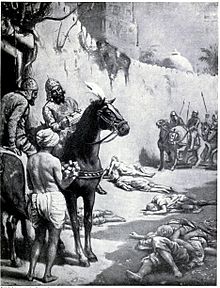Ikhtiyār al-Dīn Muḥammad Bakhtiyār Khaljī,[2] (tiếng Pashtun: اختیارالدین محمد بختیار غلجي, tiếng Bengal: ইখতিয়ারউদ্দীন মুহাম্মাদ বখতিয়ার খলজী) cũng gọi là Bakhtiyar Khalji,[3][4] là một vị tướng và người cai trị Thổ-Afghan[5][6] cai trị Ghurid Muhammad của Ghor,[7] người đã chỉ huy các cuộc chinh phục của người Hồi giáo ở các vùng Bengal và Bihar phía đông Ấn Độ và tự xưng vương các khu vực này.[8][9][10][11] Ông là người sáng lập vương triều Khalji của Bengal, cai trị Bengal trong một thời gian ngắn, từ năm 1203 đến 1227.
Thông tin Nhanh Ikhtiyar al-Din Muhammad Bakhtiyar Khalji, Vua (Bengal-Bihar) ...
| Ikhtiyar al-Din Muhammad Bakhtiyar Khalji |
|---|
| Amir al-Muminin of Bengal |
 Muhammad bin Bakhtiyar Khalji và chiến binh tùy tùng của ông là Subahdar Awlia Khan dẫn đầu đoàn quân tàn sát các tăng sĩ Phật giáo. Minh họa đầu thế kỷ 20. [1] |
| Vua (Bengal-Bihar) |
|---|
| Tại vị | khoảng năm 1203 – 1206 |
|---|
| Tiền nhiệm | (chức vụ được thiết lập) |
|---|
| Kế nhiệm | Muhammad Shiran Khalji |
|---|
| Thông tin chung |
|---|
| Sinh | k. 1150
Garmsir, Helmand, Afghanistan |
|---|
| Mất | k. 1206
Devkot , Nam Dinajpur, Tây Bengal |
|---|
| An táng | 1206
Pirpal Dargah, Narayanpur, Gangarampur, Tây Bengal |
|---|
| Clan | Khilji |
|---|
| Nghề nghiệp | Tướng quân đội
vua |
|---|
| Tôn giáo | Sunni Islam |
|---|
Đóng
Cuộc xâm lược của Khalji vào tiểu lục địa Ấn Độ từ năm 1197 đến năm 1206 đã khiến hàng loạt tăng sĩ Phật giáo chạy trốn, ông đã chỉ huy thực hiện cuộc đại đồ sát khoảng 3000 tăng sĩ Phật giáo,[12] đồng thời gây thiệt hại cho các cơ sở giáo dục đại học truyền thống của Phật giáo ở miền Bắc Ấn Độ.[13] Ở Bengal, triều đại của Khalji là nguyên nhân dẫn đến sự dịch chuyển của Phật giáo.[14][15] Sự cai trị của ông được cho là đã bắt đầu sự cai trị của người Hồi giáo ở Bengal, đáng chú ý nhất là của Vương quốc Hồi giáo Bengal và Mughal Bengal.[16]
Hutchinson's story of the nations, containing the Egyptians, the Chinese, India, the Babylonian nation, the Hittites, the Assyrians, the Phoenicians and the Carthaginians, the Phrygians, the Lydians, and other nations of Asia Minor. London, Hutchinson. 1906. tr. 169. Hussain, Syed Ejaz (2003). The Bengal Sultanate: Politics, Economy and Coins (AD 1205–1576). New Delhi: Manohar. tr. 27. ISBN 9788173044823. Know Your State West Bengal. Arihant Experts. 2019. tr. 15. Turk-Afghan Rule: Muhammad Bakhtiyar Khilji's invasion to Bengal marked the advent of Turk-Afghan rule in Bengal.
Chandra, Satish (2004). Medieval India: From Sultanat to the Mughals-Delhi Sultanat (1206-1526). tr. 226. Although the Afghans formed a large group in the army of the Delhi Sultanat, only few Afghan nobles had been accorded important positions. That is why Bakhtiyar Khalji who was part - Afghan had to seek his fortune in Bihar and Bengal.
Majumdar, R. C. (1973). History of Mediaeval Bengal. Calcutta: G. Bharadwaj & Co. tr. 1–2. OCLC 1031074. Tradition gives him credit for the conquest of Bengal but as a matter of fact he could not subjugate the greater part of Bengal ... All that Bakhtyār can justly take credit for is that by his conquest of Western and a part of Northern Bengal he laid the foundation of the Muslim State in Bengal. The historians of the 13th century never attributed the conquest of the whole of Bengal to Bakhtyār.
Mehta, Jaswant Lal (1986) [First published 1979]. Advanced Study in the History of Medieval India. I (ấn bản thứ 2). Sterling Publishers. tr. 81–82. ISBN 978-81-207-0617-0. OCLC 883279992. The Turkish arms penetrated into Bihar and Bengal through the enterprising efforts of Ikhtiyaruddin Muhammad bin Bakhtiyar Khalji ... he started plundering raids into Bihar and, within four or five years, occupied a large part of it ... Nadia was sacked by the Turks and a few districts of Bengal (Malda, Dinajpur, Murshidabad and Birbhum) were occupied by them ... Bathtiyar Khalji could not retain his hold over Nadia and made Lakhnauti or Gaur as his capital.
Hartmut Scharfe (2002). Handbook of Oriental Studies. BRILL. tr. 150. ISBN 90-04-12556-6. Nalanda, together with the colleges at Vikramasila and Odantapuri, suffered gravely during the conquest of Bihar by the Muslim general Muhammad Bhakhtiyar Khalji between A.D. 1197 and 1206, and many monks were killed or forced to flee.
Hindu-Muslim Relations in Bengal, 1905–1947: Study in Cultural Confrontation, Page 11, Nachiketa Publications, 1974, Hossainur Rahman
